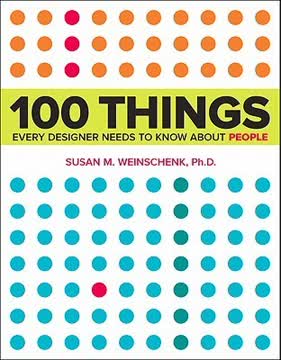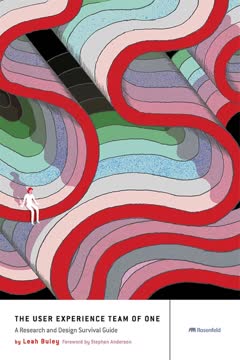Key Takeaways
1. UX teams of one face unique challenges but can drive significant impact
UX teams of one are people who love users and also make sure that designs get tested, business people's questions are answered, design problems receive an appropriate amount of creative exploration, UX specifications are implemented according to plan, the product is continually monitored and improved upon, and support for UX is ever growing.
Wear many hats. As a UX team of one, you'll likely handle research, design, testing, and evangelism single-handedly. This requires being a jack-of-all-trades and master of prioritization. You may feel spread thin at times, but your unique position allows you to see the big picture and drive user-centered improvements across the entire product development process.
Build support strategically. Without a large UX team behind you, garnering buy-in is crucial. Focus on educating colleagues about UX, demonstrating its value through quick wins, and cultivating allies across departments. Position yourself as a facilitator who can help the whole team create better products, not just a siloed specialist.
Embrace constraints creatively. Limited time and resources can actually spur innovation. Get scrappy with guerrilla research methods, paper prototypes, and quick usability tests. Your nimbleness as a team of one allows you to iterate rapidly and find clever solutions to user problems.
2. Establish a clear UX process and toolkit to guide your work
Make sure that you are considering all the standard parts of the UX process and assessing whether and if each part applies.
Define your process. Create a flexible UX framework tailored to your organization's needs and constraints. This typically includes stages for discovery, research, design, testing, and implementation. Having a clear process helps set expectations with colleagues and ensures you don't skip critical steps.
Assemble your toolkit. Identify the key methods and deliverables you'll use at each stage. For example:
- Discovery: Stakeholder interviews, competitive analysis
- Research: User interviews, surveys, personas
- Design: Sketching, wireframing, prototyping
- Testing: Usability testing, A/B testing
- Implementation: Design specifications, developer collaboration
Adapt as needed. Be prepared to adjust your process for different projects. Sometimes you'll need to compress timelines or focus more heavily on certain phases. The key is having a foundational framework to guide you while remaining agile.
3. Research users to truly understand their needs and behaviors
Simply put, if you can quickly make examples of what you and your colleagues are talking about (even the sketchiest, most rudimentary examples), you can break the conversational cycle and instead help foster a constructive evolution of shared vision.
Get out of the building. Nothing beats talking directly to users in their own environment. Even if you can only do a handful of guerrilla interviews or observations, the insights gained will be invaluable. Look for workarounds, pain points, and unmet needs that could inspire design solutions.
Use a mix of methods. Triangulate findings using both qualitative and quantitative approaches:
- Interviews and observations for rich, contextual insights
- Surveys for broader trend data
- Analytics to understand actual user behavior
- Usability testing to identify interface issues
Create actionable deliverables. Translate research into tools the whole team can use to stay user-centered:
- Personas to build empathy
- Journey maps to visualize the user experience
- Design principles to guide decision-making
- Opportunity matrices to prioritize improvements
4. Sketch and prototype to explore design ideas collaboratively
Sketches are messy. No one could confuse them with finished designs. Consequently, if you share a sketch with someone (for instance, a team member), they're more likely to give feedback on the core concept than to give you detailed feedback on layouts, fonts, colors, and so on.
Start on paper. Begin with quick sketches to rapidly explore different concepts. This allows you to consider many options before committing to a direction. Sketching is fast, cheap, and encourages creative thinking.
Involve others. Host collaborative sketching sessions with colleagues from different departments. This builds buy-in and surfaces diverse perspectives. Use techniques like design studios or crazy eights to generate lots of ideas quickly.
Iterate and refine. Move from rough sketches to more detailed wireframes and prototypes. Each iteration should test and validate assumptions:
- Paper prototypes for early concept testing
- Digital wireframes to refine layout and flow
- Interactive prototypes to test key interactions
- Visual comps to refine aesthetics
5. Test designs early and often with quick, informal methods
Finishing a UX project is like sweeping a floor. You get the big pile fairly easily, but those last few specks of dust are impossible to ever really clean up. You just keep cutting the dirt pile in half until finally you're left with an acceptable amount of grime to put the broom away and get on with the next thing.
Embrace imperfection. Don't wait for polished designs to start testing. Even rough prototypes can yield valuable insights. The goal is to identify major usability issues and validate core concepts early when changes are easier and cheaper to make.
Use lightweight methods. Quick, informal testing approaches allow for frequent iteration:
- Hallway usability testing with colleagues
- 5-second tests to gauge first impressions
- Preference tests between design options
- Remote unmoderated testing for quick feedback
Focus on key tasks and flows. Prioritize testing the most critical user journeys and features. This ensures you're addressing the most impactful areas first. Be prepared to make changes based on findings, even if it means rethinking initial assumptions.
6. Build support by involving others and demonstrating value
Relationships are one of the most important means by which you can establish a foundation for UX.
Educate and involve. Help colleagues understand UX principles and methods. Invite them to participate in research, sketching sessions, and usability tests. This builds empathy for users and appreciation for the UX process.
Communicate clearly. Translate UX concepts and findings into language that resonates with different stakeholders:
- Executives: Focus on business impact and ROI
- Product managers: Emphasize user needs and product strategy
- Developers: Discuss technical feasibility and implementation
- Marketers: Connect UX to brand and customer acquisition
Show, don't tell. Use tangible examples to demonstrate UX value:
- Before/after UI improvements
- Videos of users struggling with current designs
- Analytics showing lift from UX changes
- Case studies of successful projects
7. Grow your UX skills and career through continuous learning
Keeping yourself connected to other user experience professionals outside your organization is especially important. It will help you experience continual growth and greater professional satisfaction.
Build your network. Connect with other UX professionals through:
- Local UX meetups and events
- Online communities and forums
- Professional associations like UXPA or IxDA
- Conferences and workshops
Stay current. The UX field evolves rapidly. Keep your skills sharp by:
- Reading UX books and blogs
- Taking online courses or workshops
- Experimenting with new tools and methods
- Seeking mentorship from experienced practitioners
Share your knowledge. Teaching others reinforces your own learning:
- Write articles or give presentations
- Mentor junior designers
- Contribute to open source projects
- Participate in design challenges
Last updated:
FAQ
What's "The User Experience Team of One" about?
- Focus on UX Teams of One: The book is a guide for individuals who are the sole user experience (UX) practitioners in their organizations, providing strategies to effectively manage UX tasks alone.
- Philosophy and Practice: It combines philosophical insights with practical methods to help UX teams of one champion user-centered design in environments that may not fully understand or support UX.
- Comprehensive Approach: The book covers everything from planning and research to design and testing, offering a complete roadmap for UX projects.
- Author's Experience: Leah Buley draws from her own experiences as a UX team of one, sharing real-world advice and methods that have been tested in various organizational settings.
Why should I read "The User Experience Team of One"?
- Empowerment for Solo Practitioners: It empowers UX professionals working alone to effectively advocate for and implement user-centered design practices.
- Practical Tools and Methods: The book provides a wealth of practical tools and methods that can be immediately applied to improve UX processes and outcomes.
- Building Support: It offers strategies for building support and understanding of UX within organizations, which is crucial for long-term success.
- Career Growth: The book also addresses personal and professional growth, helping readers to advance their careers in UX.
What are the key takeaways of "The User Experience Team of One"?
- Inclusive and Participatory Methods: Emphasizes the importance of involving non-UX colleagues in the design process to build support and improve outcomes.
- Iterative Design Process: Encourages an iterative approach to design, allowing for continuous improvement and adaptation based on feedback.
- Balancing Philosophy and Practice: Highlights the need to balance philosophical understanding of UX with practical application to achieve successful results.
- Building Relationships: Stresses the importance of building relationships and networks within the organization to foster a supportive environment for UX.
What is a UX team of one, according to Leah Buley?
- Definition: A UX team of one is an individual who is the primary advocate for user-centered design within an organization, often working without a dedicated UX team.
- Role and Challenges: This role involves a wide range of tasks, from research and design to testing and evangelism, often without a clear roadmap or full organizational support.
- Skills Required: It requires a blend of skills, including design, research, facilitation, and persuasion, to effectively manage UX tasks and build support.
- Common Situations: Even in organizations with multiple UX professionals, if you regularly work on a team where you are the only UX person, you are considered a UX team of one.
How does Leah Buley suggest building support for UX work?
- Invite Participation: Encourage non-UX colleagues to participate in the design process to foster a sense of ownership and understanding.
- Use Relatable Language: Avoid jargon and use plain language to explain UX concepts and their value to the organization.
- Pre-Meetings: Arrange pre-meetings with key stakeholders to gain their support and address concerns before formal presentations.
- Develop Case Studies: Create mini case studies to showcase the impact of UX work and share success stories within the organization.
What are some practical methods from "The User Experience Team of One"?
- Listening Tour: Conduct interviews with team members to understand their priorities and the current level of UX awareness.
- Opportunity Workshop: Facilitate workshops to identify and prioritize areas of the product that need UX improvements.
- Sketchboards: Use sketchboards to collaboratively explore design ideas and gather feedback from the team.
- Quick-and-Dirty Usability Test: Conduct informal usability tests with available participants to quickly validate design concepts.
What is the "Black Hat Session" method?
- Purpose: A Black Hat Session is a structured critique session where participants are encouraged to adopt a critical perspective to identify weaknesses in a design.
- Process: Participants write down issues they see on sticky notes and place them on the design, fostering an open and honest discussion about potential improvements.
- Benefits: It helps uncover design flaws, encourages candid feedback, and demonstrates a commitment to iterative improvement.
- Inclusivity: By involving a cross-functional team, it ensures diverse perspectives are considered in the design process.
How does Leah Buley address career growth for UX teams of one?
- Professional Communities: Encourages joining professional associations and online communities to connect with other UX professionals and share knowledge.
- Continuing Education: Recommends pursuing online courses, attending conferences, and reading relevant books to stay updated on UX trends and skills.
- Strategic Planning: Advises aligning UX work with business goals and measuring progress to demonstrate value and advocate for career advancement.
- Mentorship: Suggests finding mentors or becoming one to gain insights and support in navigating career challenges.
What are the best quotes from "The User Experience Team of One" and what do they mean?
- "UX is a force for good." This quote emphasizes the positive impact that user-centered design can have on creating technology that enriches human lives.
- "The world needs more of it." Highlights the growing importance of UX as technology becomes more integrated into everyday life, creating a demand for user-friendly products.
- "You can make that happen." Encourages individuals to take initiative in spreading UX practices, regardless of their current role or organizational support.
- "Design is the act of creating new solutions under constrained circumstances." Reflects the creative challenge of UX design, where constraints are seen as opportunities for innovation.
What is the role of user research in "The User Experience Team of One"?
- Foundation of UX: User research is fundamental to understanding user needs and designing products that meet those needs effectively.
- Guerilla User Research: The book advocates for informal, quick research methods to gather insights when resources are limited.
- Learning Plan: Encourages creating a learning plan to identify knowledge gaps and determine how to fill them through research.
- Validation: User research is crucial for validating design concepts and ensuring they align with user expectations and behaviors.
How does Leah Buley suggest handling organizational issues?
- Visualize Requirements: Offer to help visualize requirements early in the process to ensure UX considerations are integrated from the start.
- Develop Case Studies: Use case studies to demonstrate the value of UX work and build a narrative around its impact.
- Play Nicely with Vendors: Collaborate with external vendors to learn from their expertise and integrate their work with internal efforts.
- Turn Rubber Stamps into Opportunities: Use late-stage UX involvement as a chance to educate the team about the benefits of user-centered design.
What is the "Pyramid Evangelism" method?
- Building Relationships: Pyramid Evangelism involves connecting with people at all levels of the organization to build support for UX.
- One-on-One Conversations: Focuses on having individual conversations to understand colleagues' needs and demonstrate how UX can help.
- Social Engagement: Encourages informal social interactions, like lunch or coffee, to build rapport and trust.
- Long-Term Strategy: Emphasizes patience and persistence in building a network of supporters over time to create a sustainable UX practice.
Review Summary
The User Experience Team of One receives positive reviews for its practical guidance on UX design for solo practitioners. Readers appreciate its comprehensive overview of UX methods, tools for gaining organizational support, and adaptable techniques for resource-constrained environments. Many find it valuable for both beginners and experienced designers, praising its accessible writing and visual aids. Some criticize the theoretical sections as less useful, while others note outdated technology references. Overall, reviewers recommend it as a helpful resource for UX professionals working independently or in small teams.
Similar Books










Download PDF
Download EPUB
.epub digital book format is ideal for reading ebooks on phones, tablets, and e-readers.




